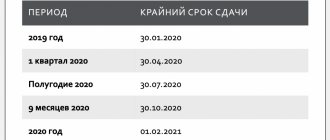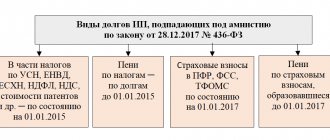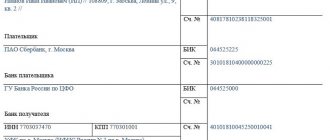Mistake #1. Calculation of contributions for SMEs in case of exceeding the maximum base value (corrected)
For organizations that have established a preferential tariff for SMEs since April 2021, if the maximum value of the contribution base is exceeded, the amount of contributions is calculated incorrectly.
For more details, see - “Error” in 1C programs when calculating insurance premiums at a preferential rate for small and medium-sized businesses
The error was fixed in ZUP versions 3.1.10.491 and 3.1.14.97.
After updating the program to correctly account for the amounts of contributions to the DAM , they should be recalculated in a special way.
For more details, see - Attention! Rules for recalculating contributions after updating to ZUP 3.1.10.491/3.1.14.97 at a preferential rate for SMEs in case of exceeding the maximum value of the contribution base
Calculation of contributions to compulsory pension insurance when the maximum base is exceeded
The procedure for calculating contributions to compulsory pension insurance if the established income limit is exceeded depends on what tariff you apply.
You can find out what payments are included in the maximum base from this article.
If contributions are calculated at the general rate - 22%
Until the employee’s income from the beginning of the year exceeds the limit of RUB 1,292,000, calculate contributions at the basic rate - 22%.
Mistake #2. Adjustment of the DAM not related to changes in personal data (corrected)
When submitting adjustments on the DAM that are not related to changes in personal data, namely the combination of “SNILS”, “Last Name, First Name, Patronymic”, a negative protocol is received with the error that “In p.3 there cannot be two sheets with the same values of SNILS indicators and full name.
For more details, see - Erroneous filling of the corrective RSV in ZUP 3.1
Error logged - Error 10223005.
The error was fixed in ZUP versions 3.1.10.511 and 3.1.14.129
What do premiums over the limit mean?
When the amount of payments to each employee during the year reaches the cumulative total of exceeding the limit on insurance premiums for 2020 (see above), the procedure for calculating contributions in excess of the limit changes. Namely:
- contributions in case of temporary disability/maternity cease to accrue ;
- contributions to compulsory pension insurance are charged at a lower rate of 10%.
EXAMPLE 1: compliance with the contribution limit to the Social Insurance Fund in 2021
In 2021, Erokhin’s salary at Guru LLC, according to the employment contract, is 150,000 rubles (we agree that there are no other payments subject to insurance contributions). Thus, her income from January to June inclusive will be:
150,000 rub. × 6 months = 900,000 rub.
That is, during these months there is no excess of the limit on contributions to OSS (912,000 rubles).
Taking into account July 2021, its cumulative income from the beginning of the year will be:
150,000 rub. × 7 months = 1,050,000 rub.
It will exceed the limit on contributions to OSS for cases of disability and maternity in 2021:
912,000 rub. <1,050,000 rub.
This means that the accounting department of Guru LLC must stop calculating and paying insurance premiums for OSS (2.9%) from July 2021. Including starting from the following amount of exceeding the limit:
RUB 1,050,000 – 912,000 rub. = 138,000 rub.
EXAMPLE 2: compliance with the limit on pension contributions in 2020
In 2021, Erokhin’s salary at Guru LLC, according to the employment contract, is 150,000 rubles (we agree that there are no other payments subject to insurance contributions). Thus, her income from January to August inclusive will be:
150,000 rub. × 8 months = 1,200,000 rub.
That is, during these months there is no excess of the limit on contributions to compulsory pension insurance (RUB 1,292,000).
Taking into account September 2021, its cumulative income from the beginning of the year will be:
150,000 rub. × 9 months = 1,350,000 rub.
He will exceed the limit on contributions to compulsory pension insurance in 2021:
RUB 1,292,000 <1,350,000 rub.
This means that the accounting department of Guru LLC, starting from September 2021, must begin to charge and pay insurance premiums for compulsory health insurance for Erokhin at a reduced rate of 10%, and not the general 22%. Including the following amounts over the limit:
RUB 1,350,000 – 1,292,000 rub. = 58,000 rub.
Mistake #4. Control ratios in the DAM for the SME tariff (corrected)
When using the SME preferential tariff, an error occurs when checking control ratios in the DAM:
“Check of subsection 3.2.1 to Section 3 (KS 1.197)
If in Subsection 3.2.1 R.3 for an individual (set of SNILS + full name indicators) line 130 = MS, then line 130 = NR line 150 = minimum wage for each value line 120"
Error logged - Error 10223815.
It arises due to an incorrect CS prescribed in the Letter of the Federal Tax Service dated 05/29/2020 N BS-4-11/ [email protected] The correct CS was published in the Letter dated 06/23/2020 N BS-4-11/ [email protected]
The error was fixed in ZUP versions 3.1.10.511 and 3.1.14.129
Features of contributions to the Pension Fund over the limit
Please note that the Pension Fund of the Russian Federation charges insurance premiums above the limit when they are calculated according to basic tariffs. But when calculating contributions to compulsory health insurance at additional tariffs, the limit does not apply (clause 5 of Article 421 of the Tax Code of the Russian Federation). That is, they continue to be charged at a rate corresponding to the class of working conditions.
EXAMPLE
Erokhin is employed at Guru Chemistry LLC in hazardous production and, according to her employment contract, receives 150,000 rubles per month. The subclass of her working conditions is 3.2, the additional tariff rate for it is 4%.
That is, for the entire year 2021, the accounting department of Guru Chemistry LLC charges insurance premiums for compulsory insurance at a rate of 22% + 4% from 150,000 rubles per month.
But when paying pension insurance contributions at reduced rates (Article 427 of the Tax Code of the Russian Federation), from amounts of payments to individuals exceeding the limit for this type of insurance, contributions are not calculated or paid (letter of the Ministry of Finance dated August 13, 2019 No. 03-15-06/ 61097).
EXAMPLE
Erokhin works for an IT company that pays insurance premiums for compulsory health insurance at a reduced rate - 8% (Article 427 of the Tax Code of the Russian Federation). In 2020, Erokhin’s salary at Guru Soft LLC, according to the employment contract, is 150,000 rubles (we agree that there are no other payments subject to insurance contributions).
Thus, her income from January to August inclusive will be:
150,000 rub. × 8 months = 1,200,000 rub.
That is, during these months there is no excess of the limit on contributions to compulsory pension insurance (RUB 1,292,000).
Taking into account September 2021, its cumulative income from the beginning of the year will be:
150,000 rub. × 9 months = 1,350,000 rub.
He will exceed the limit on contributions to compulsory pension insurance in 2021:
RUB 1,292,000 <1,350,000 rub.
This means that the accounting department of Guru Soft LLC, starting from September 2021, must stop accruing and paying insurance premiums for compulsory health insurance for Erokhin from the following amount exceeding the limit:
RUB 1,350,000 – 1,292,000 rub. = 58,000 rub.
Read also
22.09.2019
Mistake #9. Erroneous distribution between the basic and SME tariffs for UTII
When using a preferential SME tariff, in some cases in the DAM , an erroneous distribution of contributions between the basic and preferential tariff may occur if the UTII regime is present.
As a workaround, you can perform the following steps:
- Temporarily delete % UTII Payroll and contributions
- Enter Recalculation of insurance premiums (Taxes and contributions - Recalculation of insurance premiums) in the same month as Calculation of salaries and contributions . It will transfer the amount of contributions from UTII to the general regime.
- Fill out the RSV .
- Return % of UTII in the document Calculation of salaries and contributions .
- Delete Recalculation of insurance premiums .
New limits on insurance premiums for 2020
Traditionally, the Russian Government determines the limit for calculating contributions in relation to two types of insurance premiums:
- for compulsory social insurance (OSI) in case of temporary disability (sick leave) and in connection with maternity (paid to the Social Insurance Fund);
- for compulsory pension insurance (OPI) (paid to the Pension Fund).
According to the decree of the Russian Government, the limit on the calculation of insurance premiums in 2021 is:
- contributions in case of temporary disability and maternity – 912,000 rubles inclusive ;
- contributions to compulsory health insurance – 1,292,000 rubles inclusive .
Please note that the maximum limit on insurance premiums for compulsory health insurance has not been established since 2015. That is, regardless of the cumulative income from the beginning of 2021, insurance premiums to the Compulsory Medical Insurance Fund must continue to be accrued and paid in the general manner.
Error for disabled organizations (fixed)
If an organization that previously had an insurance premium rate - Organizations of Disabled Persons - establishes a preferential rate for SMEs, then for non-disabled employees, contributions for “injuries” will no longer be calculated at a preferential rate.
Error logged - Error 60000883
The error was fixed in ZUP versions 3.1.10.511 and 3.1.14.129.
After updating to a release in which the error is corrected, in the organization’s accounting policy ( Organization - Accounting policy tab and other settings - Accounting policy ), in addition to the tariff For small or medium-sized businesses, the Organization of disabled people checkbox
Next, you will need to create separate documents Recalculation of insurance premiums (Taxes and contributions - Recalculation of insurance premiums) for each month of the second quarter and calculate them. Negative amounts for contributions “for injuries” should appear. For example, this is what the recount for April 2021 will look like:
The changes made will require reformation of the documents Reflecting wages in accounting (Salary - Reflecting wages in accounting) for the second quarter of 2021 or making manual adjustments to the amounts of contributions “for injuries” (reductions by the amount of recalculations) in the June Reflection of wages in accounting .
Calculation of contributions to VNiM when the maximum base is exceeded
Until the employee’s income exceeds RUB 912,000, calculate contributions at a rate of 2.9%. Once exceeded, contributions are no longer required.
Example 4
The salary of lawyer I.L. Makeev at Kadrovik LLC in 2021 amounted to 88,000 rubles. per month.
Income from January to October - 880,000 rubles. In November, Makeev’s income will exceed the limit of 912,000 rubles. and will amount to 968,000 rubles. This means that from December there is no need to accrue contributions to VNiM.
For the period from January to October, Makeev’s income paid insurance premiums to VNiM in the amount of 25,520 rubles. (880,000 * 2.9%). In November, you need to calculate on what income you do not need to pay contributions:
- 56,000 rub. — income from which contributions no longer need to be calculated (968,000 – 912,000).
- 32,000 rub. - income from which contributions must be calculated at a rate of 2.9% (88,000 - 56,000);
Thus, deductions for VNiM in November will amount to 928 rubles. (32,000 * 2.9%).
Why the Federal Tax Service may reject the calculation
First of all, make sure that the total amount of calculated contributions to compulsory pension insurance (CPI) as a whole for the payer for each month from a base not exceeding the limit (line 061 of subsection 1.1 of Appendix 1) is equal to the amount of calculated contributions to compulsory pension insurance for the corresponding month from base not exceeding the maximum value for all individuals (lines 240 of subsection 3.2.1; see table, block 1).
If an enterprise pays contributions to compulsory pension insurance at additional tariffs, then one more equality must be satisfied (see table, block 2). The total amount of calculated additional tariff contributions for the payer as a whole for each month (lines 050 under subsections 1.3.1 and 1.3.2) must be identical to the amount of additional tariff contributions for each month for all individuals (lines 290 of subsection 3.2.2).
If the equalities are not met, then the Federal Tax Service no later than the next day after receiving the calculation (or within 10 days if the calculation was submitted on paper) sends a notification to the payer that the calculation has not been submitted.
It will also be considered that the calculation has not been submitted if, when reconciling the personalized information (lines 070–100 of subsection 3.1) with the base of the “Centralized Taxpayer Accounting” subsystem, a discrepancy between the SNILS and the full name of the individual is revealed. To avoid such errors, enter the data in section 3 directly from the insurance certificate (or a scanned copy of it). Better yet, check the full name and SNILS of individuals with the Pension Fund of the Russian Federation in advance. Failure to comply with other control ratios, which are specified in the letter of the Federal Tax Service dated March 13, 2017 No. BS-4-11 / [email protected] , cannot serve as a reason for refusal to accept the calculation.
Checking indicators in the RSV
“Calculation of insurance premiums” is required for submission by all employers, regardless of whether they operated in the current reporting period or not. The current form is contained in the order of the Federal Tax Service dated September 18, 2019 No. ММВ-7-11/ [email protected] During a desk audit, tax officials verify the data specified in the calculation in conjunction with other indicators. The indicators are verified both in the DAM itself (intra-documentary) and with data from other reporting, for example, form 6-NDFL (inter-documentary).
Basic control ratios for the DAM for 2021. are listed in the letter of the Federal Tax Service dated 02/07/2020 No. BS-4-11 / [email protected] A discrepancy in the indicators may indicate an error, therefore, if discrepancies are detected, the policyholder will be asked for clarification.





